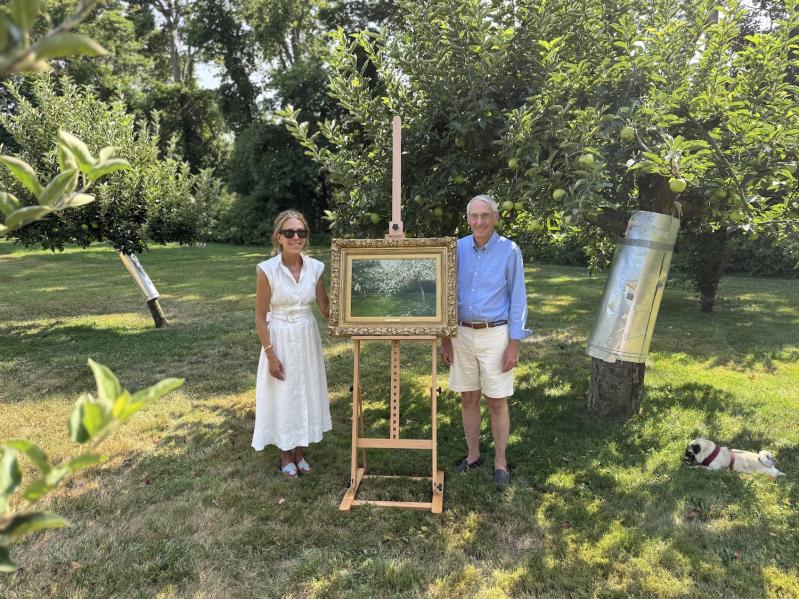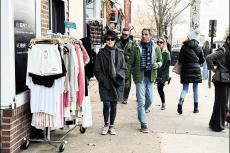Robert Hefner, formerly East Hampton Village’s historic district consultant, received a call in November from his good friend Richard Barons, former executive director of the East Hampton Historical Society, informing him that an 1894 painting by the 19th-century artist Mary Nimmo Moran would be coming up for auction the following week. The two had worked together on the restoration of the Moran Studio on Main Street, built in 1884 for Mary and her husband, the painter Thomas Moran, but neither had ever seen that painting, which was dated five years before her untimely death from typhoid fever.
Mr. Hefner quickly sent the listing, which identified the painting as “Cherry Blossoms,” to his sister-in-law, Kay Spear Gibson, who explained this week that she and Mr. Hefner had been searching for some time for a suitable tribute to honor her sister, and his wife, Isabel (Min) Spear Hefner, who died in 2023 of breast cancer.
Nothing had yet felt right, Ms. Spear Gibson said, but when she saw the image she “instantly knew” that the painting would be the perfect way to memorialize her sister’s “beauty, her incredible bravery. I just looked at it and thought, that’s it . . . and also, it was painted by a great American woman painter in the village where we grew up, so all these threads came together.”
They determined to buy the painting and donate it to the historical society in Ms. Hefner’s name, which — after a nerve-racking bidding process — they have done. Neither saw the painting in person until it arrived at the Hefner house in Amagansett. “It was more beautiful than we’d remembered,” Mr. Hefner said.
But he also noticed, having grown up on an apple orchard in Massachusetts and then grown his own apple trees here for 25 years, that the colors of the blossoms and the appearance of the tree bark were not consistent with cherry trees, as the listing said. “I looked at it and said, ‘No, that’s an apple tree.’ ”
Mr. Hefner consulted his own historic structure report on the Moran Studio, which includes a list of Mary Nimmo Moran’s paintings, recorded by her husband after her death. One of them, titled “A Young Apple Tree in Blossom in Dr. Edward Osborn’s Orchard,” was listed at 14 by 20 inches, the same dimensions as the painting they’d purchased.
“We wanted to donate it as that, because it’s so much more evocative,” Mr. Hefner said. “She could see it through the window, right outside through the gate.” (Dr. Osborn lived next door to the Morans, and his orchard would have been visible from their studio.) “So now it tells a whole story about how she painted it.”
He spent months researching to confirm his theory. The main point of contention was a greenhouse, visible in the background of the painting, which Dr. Osborn was not known to have had on his property — in fact, Mr. Hefner knew of only one greenhouse in all of East
Hampton in 1894, located at a nursery on Newtown Lane. Eventually, however, he had a breakthrough, discovering a small item printed in the October 16, 1891, issue of The East Hampton Star: “Dr. Osborn has had a conservatory added to the north side of his house.”
He presented his findings to Shannon Vittoria, a pre-eminent scholar of the artist’s work, who deemed it an “airtight case.”
“I really feel that we were guided by an invisible hand,” Ms. Spear Gibson said of their discovery. Mary Nimmo Moran’s early paintings were more similar in style to her husband’s work, she noted; later, she dedicated most of her career to etching. These final paintings, said Ms. Spear Gibson, suggest a painter much more comfortable in her own skin. “It seems like she had been a little overshadowed in her life by her famous husband,” she said. “That’s another part of what is so wonderful about this — it’s showcasing her, letting her step out of the shadows a bit.”
The painting will be unveiled during a reception at the Moran Studio at 5:30 p.m. on Monday, where it will be displayed alongside two other works completed by the artist during the mid1890s. One depicts Dr. Osborn’s garden; the other, the flower-lined walkway to the Moran House and Studio. According to her husband’s record, she’d been working on another painting of an apple orchard at the time of her death, but its whereabouts are not known.
“I was so grateful for their generosity, and I’m also just grateful for the research that Bob put into really fleshing out the provenance,” said Steve Long, who took over from Mr. Barons as the executive director of the historical society in 2021, during a phone call last week. “It’s especially wonderful to have work that not only was made here, but also depicts life in our community.” The rediscovery of this painting, he hopes, will place its creator “back in the forefront” of East Hampton’s history as an arts community.
What Ms. Spear Gibson loves most about the painting, she said, is the way Mary Nimmo Moran captured “that moment — that fresh, best moment of spring, that’s here and gone.” Min Spear Hefner, her sister, would have loved it, too, she said — even before realizing that it depicted an apple orchard, so similar to the view she had from her window of their own apple orchard on Town Lane.




